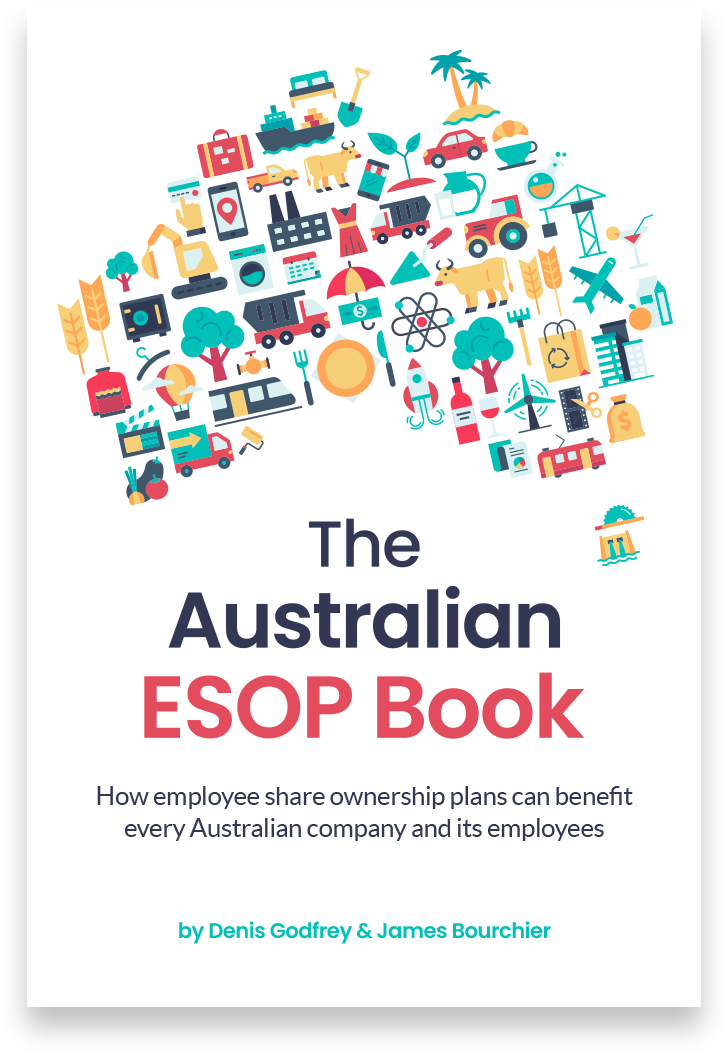The two biggest challenges to successful ESOPs are:
- cost to the company and
- low participation due to employee risk aversion.
Both can be mitigated or eliminated.
At the heart of the problem has been the trade-off between employers and employees in taking on cost and risk. Companies can minimise ESOP cost and risk by requiring salary sacrifice to participate, but employees will generally not do so unless the cost and risk are carried or shared by the company through discounts, matching, providing “free” equity or having a “no loss” provision in relation to salary sacrificed amounts.
The one ESOP that fully addresses these risks for both groups is The Share Save Plan™:
- Company cost is minimised because the grants are usually fully funded via salary sacrifice and enhanced tax deductions, while
- Employees face minimal risk because of the cash-back capital protection.
Another challenge is the apparent complexity of frequently changing tax and compliance requirements – but this is easily overcome by engaging experts in plan design and maintenance, and a plan administrator.
Cost to Company
There are two costs to the company:
- administration, and
- providing benefits over and above salary sacrifice amounts, if any.
Experience indicates that administration costs are not a major barrier to implementing an ESOP. This is because of competition between providers and efficiencies due to the better providers embracing technology, leading to lower administration costs.
The major cost to the company can be in providing benefits. For example, a company with a large workforce of 30,000 employees and providing $1,000 of free shares per employee per annum will face an annual cost of $30 million. Even if the company had only 3,000 employees the annual cost would be $3 million which is still significant for most companies. Such a cost should be delivering substantial benefits to companies in terms of alignment, engagement, and retention, but the most common types of ESOPs, such as the $1,000 Tax Exempt Plan, clearly are not achieving this because the legislation prohibits vesting conditions, or because of the risks employees are exposed to when investing their own funds, and the low value of benefits. For these reasons, traditional ESOPs often suffer from low participation rates, which lowers the return on investment from development and administration costs.
Prior to the introduction of accounting standard AASB2 (share-based payments), it was possible to offer employees options or share rights without any expense being recognised in a company’s accounts. However, since 2005 it has been necessary for companies to determine the value of share-based payments and amortise those values in the company’s accounts.
In addition, the accounting expense does not qualify as a tax deduction for the company. There are exceptions such as when employee share trusts are used to generate tax deductions for companies and for tax exempt benefits under the $1,000 tax exempt plan under a dedicated provision of the Income Tax Assessment Act introduced for this type of scheme, but not available under other arrangements.
The introduction of AASB2 was the death knell for many ESOPs that were in place at the time. Cost continues to represent the largest impediment to new ESOPs and is the main reason for the discontinuation or restructuring of current ESOPs. The ESOPs that have fared worst from a cost point of view are:
- Share Purchase Loan Plans which involved nil or low interest limited recourse loans to fund Share purchases – these were the most common form of ESOP in Australia in the period prior to 2005 and to our knowledge have ceased to be used as ESOPs (a small number have survived usually as executive only plans), and
- $1,000 Tax Exempt Plans which are usually operated on the basis of an additional benefit involving additional company cost – this is the plan type that is most at risk of not being introduced or being discontinued or replaced by companies due to cost reasons.
Company cost can be addressed by several means including:
- Using salary sacrifice to fund equity acquisitions – these involve no additional company cost, but exposes employees to risk of loss and the plan backfiring in terms of alignment/motivation, if the share price falls,
- Using matching allocations to enhance a salary sacrifice approach but on a basis that limits company cost to an acceptable level. While employers tend to view the “free” matching shares as providing a discount and risk protection against a falling share price, employees generally do not see it this way, and will view any falling share price as a loss, even if they are still ahead on their investment when taking into account the matching shares.
- Limiting participation to groups of employees where it may be expected that the ESOP will produce significant benefits for the company – company cost may be offset by savings in other areas such as reduced recruitment and training cost when employee turnover decreases, or productivity improves. This is not possible for the $1,000 TEP which must be offered to 75% of qualifying Australian employees,
- Using the ESOP to deliver awards related to employee performance and/or service that would otherwise have been paid in cash, on a voluntary or compulsory basis i.e. no additional company cost,
- Using an employee share trust (EST) to generate tax savings for the company which exceed those applicable to the amount of salary sacrifice and therefore benefit the company and subsidise the cost of providing benefits under the ESOP (this is not available under a $1,000 TEP), and
- Using a modern plan structure like a The Share Save Plan which is based on salary sacrifice (no cost to provide the benefit) and can be expected to create financial returns for the employer when share prices are rising through enhanced tax deductions, while offering employees capital protection against a falling share price at no cost to the employer.
To take advantage of these cost saving approaches companies need to expand the range of plans that they consider, and this will most likely lead to the two specific tax concession plans (Tax Exempt Plan & Deferred Share Plan) not being used.
Two Employee Risks
Employee risk in relation to ESOPs arises in several ways:
- If salary sacrifice is used to purchase equity units then, in the absence of specific protection, the employee will be exposed to loss should the share price fall, and
- If the employee is taxed on the benefit provided under the ESOP before the equity is sold then the value that is subsequently realised on sale of the equity may be less than the value that was taxed and may even be less than the amount of tax paid.
i) Salary Sacrifice Risk
Whether employees should be protected from loss in respect of equity acquired with salary sacrifice amounts is a question to which various valid responses can be made.
One response is that employees should not be protected from loss because they should be treated the same as other shareholders who are exposed to both rises and falls in the share price. While there is logic in this response it can lead to lower ESOP participation rates as some employees will not be prepared to invest in equities as they perceive them to be very risky.
The issue to be faced by companies is whether they expect participation to be affected by risk. If they expect participation to be largely unaffected then there would be no need to provide risk protection. On the other hand, if the company has the view that risk may significantly adversely affect participation rates then consideration should be given to risk protection.
Risk protection may be provided by companies, in effect, guaranteeing to buy back the equity units at the prices paid by the employee, if the current share price is below the acquisition prices when the employee wishes to realise the value of the equity investments.
Under some plans such as The Share Save Plan the guarantee can be put into effect at no additional cost to the company as it is simply repaying the amount previously salary sacrificed.
ii) Tax Risk
The tax risk for employees is largely a matter of choice if employees decide to retain equity rather than sell it at the taxing point. In this regard two approaches may be considered in relation to ESOP operation. Firstly, the plan should be designed to ensure that realisation of benefits by sale of equity naturally aligns with the taxing point. Secondly, employees should be educated about the risks of retaining equity beyond the taxing point and strategies for minimising risk such as sale of sufficient equity to cover the tax liability.
What is your company’s best plan choice?
In the current environment there are choices open to companies that have a genuine interest in having an ESOP that does not involve excessive cost yet is well regarded by employees and produces meaningful advantages for the company.
In most cases, the following plan types will be the optimal plan type in the noted circumstances:
- Discretionary bonus up to $1,000 – Tax Exempt Plan.
- Maximising employee participation at lowest cost via salary sacrifice in a listed company – The Share Save Plan.
- Start-up unlisted companies – the Start-up Tax Concessions Plan.
- Other fast-growing companies (non-start-up) – Share Appreciation Rights Plan (should replace all option plans).
- Long term variable remuneration, short term variable remuneration or bonus settlement in equity, retention or sign-on awards – Rights Plan.
- Sophisticated Participant equity plans (often owning or controlling more than 10% of the Company’s shares) – Indeterminate Rights Plan.
- Unlisted company heading for liquidity event – Indeterminate Rights Plan.
- Unlisted company seeking to gradually transfer ownership – Rights Plan using indeterminate rights.
- Unlisted company looking to provide the experience of share ownership without offering genuine equity – Phantom Equity Plan.
The following plan types are unlikely to be the best choice under current frameworks because there are superior alternatives available:
- Salary sacrifice $1,000 Tax Exempt Plan, which is expensive to deploy and administer but offers only a few hundred dollars’ worth of benefit per employee.
- Deferred Share Plan, which is less flexible than other kinds of rights plans that can offer the same benefits.
- Share Option Plan, which is higher cost and more dilutive than Share Appreciation Rights.
- Share Purchase Loan Plan, which usually represents the most expensive approach and in private companies is a “one-shot” plan.





